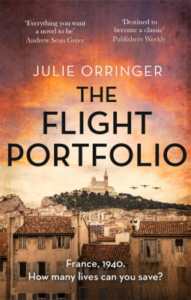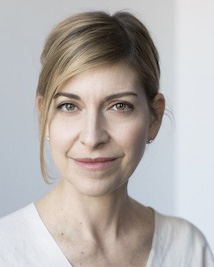By Julie Orringer; reviewed by Jeannette Hartman
 The popular Netflix limited series “Transatlantic” is loosely based on Julie Orrigner’s novel THE FLIGHT PORTFOLIO.
The popular Netflix limited series “Transatlantic” is loosely based on Julie Orrigner’s novel THE FLIGHT PORTFOLIO.
Both offer the suspense and chills of a wartime thriller, but THE FLIGHT PORTFOLIO offers so much more.
Orrigner’s novel is based on the life of the complex and conflicted Varian Fry, a journalist who had written for The New York Times from Berlin as Hitler rose to power. He helped establish the Emergency Rescue Committee, to aid distinguished writers, artists, philosophers, and scientists in danger of being arrested and turned over to the Nazi authorities.
He then volunteered to represent the ERC in Marseille. He arrived in August 1940 and worked for a year until he was deported by the French, much to the relief of U.S. diplomats who believed his often-illegal work undermined the U.S. policy of neutrality.
Overall, Fry helped save 2,000 people, including writer Franz Werfel and his wife composer Alma Mahler WerfeL; family members of writer Thomas Mann; artists Marc Chagall, André Masson, Max Ernst and Jacques Lipchitz; surrealist André Breton; poet Walter Mehring; harpsichordist Wanda Landowsk; and writer Lion Feuchtwanger.
Orringer paints a vivid picture of 1940 Marseille: the smell of seaweed and salt from the port, “the parade of sailors and girls, gangsters and spice vendors on the Canebière” and the desperation of refugees filling hotels and lining the sidewalks, halls and stairways of the building where Fry worked. Food is so scarce that it might as well have been painted on plates — unless one was eating in a restaurant run by a black marketeer.
While some refugees would do anything to get out of France, others find it hard to believe they’re in danger. Marc Chagall, for example, believes his talent and reputation will protect him — until a police raid on his hotel sweeps him into jail, from which Fry rescues him.
Two anti-Nazi German politicians, Rudolf Breitscheild and Rudolf Hilferding arbitrarily changed Fry’s carefully planned and funded arrangements for their escape. They missed their ship and refused to take third class berths on the next ship. They were arrested; Breitscheild died in Buchenwald; Hilferding in a Paris prison.
The novel adds plausible, fictional events to the facts of Fry’s work, intensifying one of its central issues: is one life more valuable than another? What and who determines who the most accomplished, most notable, most essential people are in the context of an event like the Holocaust?
When Fry shows up for an anonymous invitation to dinner, he discovers his host is a man he’d had a passionate relationship with at Harvard, who had disappeared without explanation 12 years earlier — Elliott Grant. Despite the pain of loss, Fry finds himself deeply attracted and returning to the glorious days of their earlier love.
But things are different now. Grant is in France with his current lover, Professor Katznelson, a German Jewish history professor at Columbia University. His son Tobias has fled Berlin and hasn’t been heard from in weeks. Grant is asking for Fry’s help finding him and getting him to America.
Ultimately, Fry finds himself in an impossible dilemma: in a world of finite options, one person’s documents and passage out of Vichy France means another person must stay and face possible arrest, torture and death.
Orringer’s book is filled with engaging characters, courageous acts of daring, and a vivid evocation of a rare and dangerous time when Fry and his associates attempted the impossible.
(For an alternative discussion of the challenges raised by the ERC’s work, read Dara Horn’s nonfiction look at Fry’s work, THE RESCUER.
#julieorringer #theflightportfolio #jeannettehartman
The Author: Julie Orringer (1973 – )
 Julie Orringer’s previous books were THE INVISIBLE BRIDGE, based on her family’s experience during the Holocaust and World War II, and HOW TO BREATHE UNDERWATER, a collection of stories.
Julie Orringer’s previous books were THE INVISIBLE BRIDGE, based on her family’s experience during the Holocaust and World War II, and HOW TO BREATHE UNDERWATER, a collection of stories.
She is the winner of the Paris Review’s Plimpton Prize and has received fellowships from the Guggenheim Foundation, the National Endowment for the Arts, the Cullman Center at the New York Public Library, the Radcliffe Institute for Advanced Study at Harvard, the MacDowell Colony, and Yaddo.
A native of Miami, she earned a bachelor’s degree in English from Cornell University and and a master of fine arts degree from the Iowa Writer’s Workshop and a Stegner Fellow at Stanford University.
She teaches fiction at New York University and the Stanford University Stanford in New York Program.
She lives in Brooklyn with her husband, writer Ryan Harty, and their children.


